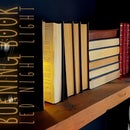Introduction: Create High Quality PCB's at Home With Cheap Laser Module
Hello fellow makers!
In this Instructable I would like to take you through the process I currently use to make high quality PCB's at home using photoresist film and a cheap 405nm laser module.
When I first started making my own PCB's at home I had to use a marker to draw my design, this is a very crude method and very difficult to design anything complex.
Next I discovered transfer paper used with a laser printer, this opened up a world of opportunities as I could now design more complex boards and print them out to transfer to the boards. Unfortunately getting a the design to transfer perfectly was quite difficult and a lot of the times some of the traces pulled away from the board and I had to do a lot of touch-ups with a marker.
So I continued looking for a better way to make prototype boards...
I knew that one of the best ways to make PCB's is with a photoresist mask but process of making a mask and exposing the film always seemed like a lot of work for a quick prototype board.
Then I got thinking...
The photoresist film is exposed with UV light, what if we use readily available cheap 405nm (UV) laser engraving modules to "draw" the design directly onto sensitised PCB?
Well, IT WORKED!
And after a lot of tinkering with the settings the results are a lot better than I ever imagined, I can now make boards with 0.2mm (size of the laser dot) traces with no problems.
Step 1: What You Will Need:
To make your own you will need the following:
- 405nm Laser module
Amazon - 500mw 405nm Laser Module Kit
- 405nm Laser safety glasses ^ Included in kit ^
- CNC/3D printer/Laser engraving machine
- Photosensitive film
- PCB Design
- Copper PCB
Amazon - Single sided copper pcb
- Washing Soda
- Hydrogen Peroxide
- Hydrochloric Acid
- Water
- Disposable containers for etching process
Step 2: Design Your PCB:
There are a few options when it comes to designing PCB's but I prefer EasyEDA as it's a free to use browser based designer.
The most important part is that we want to be able to export our design to an image format as we will essentially laser engrave the image onto the photoresist.
On EasyEDA I export my design as a PNG image with it's size set to the maximum 2.5x ( see attached image ), I do this so that I can get the highest resolution picture.
Because the image is now 2.5 times larger than the original board we will need to divide size by 2.5.
On laserGRBL this is done by selecting the "autosize", then clicking on the EXIF and then deselecting the "autosize" again.
Now take the number in either the "Size W or H" and divide it by 2.5 and enter the new measurement and it will auto correct the corresponding width or height.
Step 3: OPTIONAL - Modify Your 3D Printer:
Unfortunately during this Instructable my CNC machine started to give me some problems so I had to find another way to make my PCB's.
3D Printer to the rescue!
We can use our 3d printer for the X Y movement needed to "engrave" with the laser.
First you need a way to switch the laser on and off with a PWM pulse, most instructions on the internet use the part cooling fan output but this requires either a logic converter to get the 12/24v down to the 5v required by the laser module.
Originally when I built my 3d printer I didn't like the underpowered MOSFETs used to control the heated bed/cartridge/cooler fans so I removed them and soldered pins in their place so I could connect external MOSFET boards. This made it easy for me to connect the laser to the output pin (that is already 5v) for the cooling fan.
As the laser requires very little power to expose the PCB I used the 12v power connection for the cooling tower fan as its power source.
There are many 3d printable laser mounts available on thingiverse for popular printer models, because mine is temporary I just used a piece of double sided adhesive tape to attach it to the extruder.
Step 4: Prepping the PCB:
This step is very important as any residue on the copper would cause the photoresist film to not adhere correctly and cause the traces to lift.
Start by cutting your PCB to size, this can be done by scoring it with a sharp knife and then breaking it, cutting it with a hacksaw or I always use a Dremel with an abrasive cut off wheel.
Now take some fine steel wool and give the copper a good scrub, be thorough making sure you remove all of the oxidation.
After the steel wool you should be left with a shiny copper board, now we need to take some acetone or alcohol and with a clean cloth wipe the entire board clean making sure not to touch any part with your bare hands.
Next we need to cut a piece of the photoresist film that is just slightly larger than your PCB.
- Always work with the photoresist film in a dark room or you will expose the film -
Now remove the protective plastic film from the back of the photoresist film and lay it on your PCB, we will now need to heat up the board to make the film adhere.
For this I use the heated bed of my 3d printer, simply heat it up to 80-100degrees and leave the board on it for a minute.
When the board is heated take a soft cloth and rub the film onto the board, making sure to remove any air bubbles.
We are now ready to expose the design.
Step 5: Making the Resist:
Time for the lasers!
This step will depend on which software you are using.
If you are using a Grbl based CNC/Laser engraver/Plotter then I would highly recommend LaserGRBL.
If you are using a modded 3d printer it can be more tricky but I found a great little program that takes an image and converts it to gcode that your Marlin based printer can read.
Just compose the gcode and load it onto your printer like you would if you wanted to print something.
- IMAGE TO GCODE -
With my 500mw laser I "engrave" at 1-5% power and with a speed around 1000mm/m.
You will need to experiment a bit with your power and feed rate to get the desired results as each laser module will be slightly different.
The key to getting a perfect exposure is low power with a well focused beam.
- Remember to do all of this in a dark as possible environment -
Step 6: Developing the PCB:
To remove the unexposed film we need a development solution:
Add 1 teaspoon of washing soda to about 200ml of water, you want about a 3% solution. Adjust this according to your specific brand of photoresist film. It's best to first try with a spare piece of film, you want it to take about 3 minutes to dissolve. If your mixture is too strong you'll also disolve the developed film.
Now remove the top protective film and submerge your PCB with the film into the solution.
You will see the undeveloped film starts to get opaque and dissolve into the water.
Agitate your solution until all the undeveloped film has dissolved and you are just left with the dark blue developed resist.
Rinse with clean water.
Step 7: Time to Etch:
- WEAR ALL NECESSARY SAFETY EQUIPMENT! -
In a well ventilated room or outside mix two parts hydrogen peroxide and one part of hydrochloric acid together in a separate container. Ferric Chloride can also be used instead of this solution if you have some available. (this is your etching solution so handle with care)
Tip: The hydrogen peroxide + hydrochloric acid is a safer alternative to Ferric Chloride and is great to use when making your own PCB's
Carefully submerge the PCB into the etching solution, the copper that needs to be etched has to be completely submerged and facing upwards.
Agitate the mixture regularly.
Leave it in the solution until it has dissolved all of the exposed copper leaving behind only the copper under the resist.
When done rinse thoroughly in clean water.
Step 8: Go Wild!
Now that you have your etched PCB you can drill all the necessary holes and start assembly!
This might seem like a lot of steps but after getting the hang of it you can have your PCB's ready for assembly in under 30 minutes.
And yes there are companies that can make you professional boards for pennies, the ability to make a prototype PCB at home within a few minutes is a great tool in your arsenal.
I hope you guys find this Instructable useful and if you have any questions please feel free to leave me a comment bellow.
Please share your own creations with us by clicking the "I Made It" button below.

Grand Prize in the
Laser Challenge













